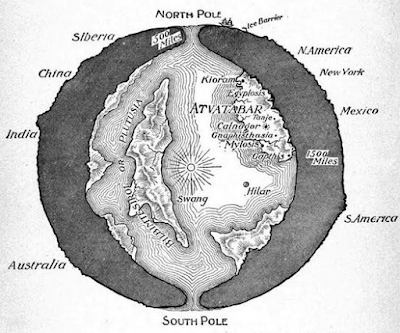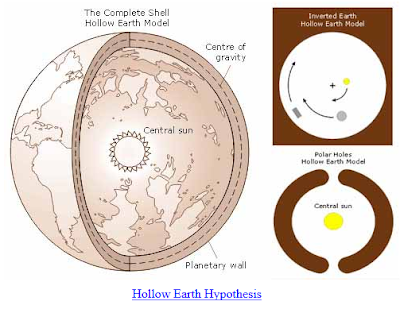Dr. Brooks Agnew of Pasadena is a supporter of the theory that our planet, like many others, is hollow. This inner plane was known in Ancient India as Agartha, the Inner-Earth. Dr. Agnew wrote a book about it, The Ark of Millions of Years, and planned an expedition on a Russian ship. But American powers-that-be found out and would not stand for it. They placed restrictions on the expedition until it had to be pushed back and possibly forever derailed. There is another publication on the topic, the book Hollow Earth: The Long and Curious History of Imagining Strange Lands, Fantastical Creatures, Advanced Civilizations, and Marvelous Machines Below the Earth's Surface by U.S. author David Standish.
All about the Inner-Earth
Crystalinks.com edited and expanded by Dhr. Seven, Pat Macpherson, Wisdom Quarterly
Agartha (also Agartta, Agharti, or Agarttha) is a legendary place that is said to reside at the Earth's core. It is related to the Hollow Earth theory and is a popular subject in esotericism.
Agartha is one of the most common names cited for the society of underground dwellers. Buddhist Shambala (also known as Shangri-La) is sometimes said to be its capital city.
The mythical paradise of Shambala is known under many different names: It has been called the Forbidden Land, the Land of White Waters, the Land of Radiant Spirits [NOTE: devas or deities in Buddhism literally means "shining ones"], the Land of Living Fire, the Land of the Living Gods, and the Land of Wonders.
Hindus have known it as Aryavartha (literally, "The Land or Realm of The Aryans," which means "The Land of the Noble or Worthy Ones") -- the land from which the Vedas [sacred texts of the Indus Valley Civilization, which has entrances in the Himalayas and around the ancient cities of the IVC].
The Chinese know it as Hsi Tien, "The Western Paradise" of Hsi Wang Mu, the Royal Mother of the West.
Russian Old Believers, a 19th-century Christian sect, knew it as Belovodye, and the Kirghiz people knew it as Janaidar. But throughout Asia it is best known by its Sanskrit name, Shambhala, meaning "the place of peace, of tranquillity."
While once a popular concept, in the last century little serious attention has been paid (with the possibly apocryphal exception of Adolf Hitler's interest when he and Nazi officials visited Buddhist Tibet and other places of ancient legend in search of artifacts, sacred texts, and remaining technology).
The theory is not yet supported by popular science, but that is not to say that compartments of our government are ignorant of its existence as entered from its Antarctic portal. [Dr. Brooks Agnew and others planned an Arctic expedition, and U.S. Navy Rear Admiral Richard E. Byrd entered via plane and was welcomed by advanced inhabitants during Operation Highjump.]
The myth of "Agartha" is also known as "Shambhala," as it is known in India, the underworld realm populated by initiates and lead by "the Masters," who are the spiritual leaders of humanity.
According to Alexandre Saint-Yves d'Alveydre (1842-1909) of France, the secret world of "Agartha" and all of its wisdom and wealth "will be accessible for all mankind, when Christianity lives up to the commandments which were once drafted by Moses and Jesus, meaning "When the Anarchy which exists in our world is replaced by the Synarchy."
All about the Inner-Earth
Crystalinks.com edited and expanded by Dhr. Seven, Pat Macpherson, Wisdom Quarterly
Agartha (also Agartta, Agharti, or Agarttha) is a legendary place that is said to reside at the Earth's core. It is related to the Hollow Earth theory and is a popular subject in esotericism.
Agartha is one of the most common names cited for the society of underground dwellers. Buddhist Shambala (also known as Shangri-La) is sometimes said to be its capital city.
The mythical paradise of Shambala is known under many different names: It has been called the Forbidden Land, the Land of White Waters, the Land of Radiant Spirits [NOTE: devas or deities in Buddhism literally means "shining ones"], the Land of Living Fire, the Land of the Living Gods, and the Land of Wonders.
Hindus have known it as Aryavartha (literally, "The Land or Realm of The Aryans," which means "The Land of the Noble or Worthy Ones") -- the land from which the Vedas [sacred texts of the Indus Valley Civilization, which has entrances in the Himalayas and around the ancient cities of the IVC].
The Chinese know it as Hsi Tien, "The Western Paradise" of Hsi Wang Mu, the Royal Mother of the West.
Russian Old Believers, a 19th-century Christian sect, knew it as Belovodye, and the Kirghiz people knew it as Janaidar. But throughout Asia it is best known by its Sanskrit name, Shambhala, meaning "the place of peace, of tranquillity."
While once a popular concept, in the last century little serious attention has been paid (with the possibly apocryphal exception of Adolf Hitler's interest when he and Nazi officials visited Buddhist Tibet and other places of ancient legend in search of artifacts, sacred texts, and remaining technology).
The theory is not yet supported by popular science, but that is not to say that compartments of our government are ignorant of its existence as entered from its Antarctic portal. [Dr. Brooks Agnew and others planned an Arctic expedition, and U.S. Navy Rear Admiral Richard E. Byrd entered via plane and was welcomed by advanced inhabitants during Operation Highjump.]
 |
| Map of Agartha (Atvatabar) from a fictionalized account by Wm. R. Bradshaw, 1892 (wiki) |
.
The idea of subterranean worlds may have been inspired by ancient religious beliefs in Hades, Sheol, and hell. Ferdynand Antoni Ossendowski's 1920 book Beasts, Men, and Gods also discusses Agartha. |
| Chakravatin, 1st cent. BCE (Guimet) |
- [This is possibly the source of Buddhist and more ancient Vedic-Brahminical chakravartins, "world monarchs." The Buddhist King Asoka, who became emperor of India with successive conquests, is called a world monarch, perhaps as an honorific title because it is unlikely that he actually was one. This lore was exploited by Hitler's Minister of Propaganda, Josef Goebbels, to promote a Germanic "Aryan" race and the idea of the Furher becoming the "ruler of the world" under Nazi domination. What gives a chakravartin power is a space ship or flying saucer described as a thousand-spoked "wheel" (chakra) flying overhead into battle where people surrender at the site of the invader's superior force so that no force has to be used. So important is this symbol that it is found at the center of the modern Indian flag. In Buddhism it is replaced by an eight-spoked Wheel of the Dharma, and presumably replaced by the ancient swastika for the Nazis, who modified it and used it as a corporate logo allegedly designed by Hitler using black, white, and red elements. It makes more sense that the swastika is a stand in for vril power, for which Aldebaran-Oracle Maria Orsich's Vril Society used a V-symbol.]
According to Alexandre Saint-Yves d'Alveydre (1842-1909) of France, the secret world of "Agartha" and all of its wisdom and wealth "will be accessible for all mankind, when Christianity lives up to the commandments which were once drafted by Moses and Jesus, meaning "When the Anarchy which exists in our world is replaced by the Synarchy."
Saint-Yves gives a "lively" description of Agartha in this book as if it were a place which really exists, situated in the Himalayas in Tibet.
Saint-Yves' version of the history of "Agartha" is based upon "revealed" information, meaning received by Saint-Yves himself through "attunement." Saint-Yves d'Alveydre created the Archaeometre.
Shambhala concept figures prominently in Vajrayana Buddhism and Tibetan Kalachakra teachings and was revived in the West by Madame Blavatsky and the Theosophical Society. As with many concepts in Vajrayana Buddhism, the idea of Shambhala is said to have an outer, inner, and secret meanings.
The outer meaning understands Shambhala to exist as a physical place, although only individuals with the appropriate karma can reach it and experience it as such.
Some say it is north of Tibet, while others maintain that there is a direct entrance down into Agartha at the Buddhist Potala Palace in Lhasa, Tibet, Vajrayana Buddhism's former "Vatican," as it were, with the Dalai Lama as "pope," prior to Chinese invasion, pillaging, and desecration.
The Hollow Earth or hollow planet theory is also supported by superconscious knowledge based channeled sources of universal nature like Seth channeled by Jane Roberts, Ramtha by J.Z. Knight, and Datre by Aona. More
The outer meaning understands Shambhala to exist as a physical place, although only individuals with the appropriate karma can reach it and experience it as such.
- [Admiral Byrd had such karma, according to his account of why he was welcomed by the inhabitants, and he was asked to spread the message of its existence, but his words fell on military ears that had no interest in spreading the truth to others outside of the military and government.]
- [This is where the Buddha was born and where legend holds that his karma -- as well as that of his son, Rahula, and his cousin and monastic attendant, Ananda -- was sufficient to become a "world monarch" had they not renounced the throne and pursued enlightenment and liberation instead].
 |
| One of the entrances to Agartha, Tibet's Potala Palace in the capital Lhasa, now in China. |
.
 |
| The little pope, 14th Dalai Lama (TIME) |
- [The Himalayan foothills extend west to another range now referred to as the Hindu Kush, which is actually part of the Himalayan range. The Buddha, according to Dr. Ranajit Pal, was born and raised in what today is Bamiyan, Afghanistan and two other royal seasonal residences (possibly Mes Aynak and Kabul/Kabil/Kapilavastu, according to Dhr. Seven and the editors of Wisdom Quarterly).]
The Hollow Earth or hollow planet theory is also supported by superconscious knowledge based channeled sources of universal nature like Seth channeled by Jane Roberts, Ramtha by J.Z. Knight, and Datre by Aona. More





































































































































































































































No comments:
Post a Comment